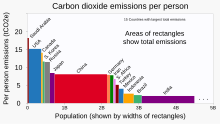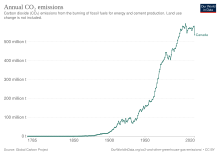

Climate change is greatly impacting Canada's environment and landscapes. Extreme weather has become more frequent and severe because of the continued release of greenhouse gases into the atmosphere. The number of climate change–related events, such as the 2021 British Columbia Floods and an increasing number of forest fires, has become an increasing concern over time.[2] Canada's annual average temperature over land warmed by 1.7 degrees Celsius between 1948 and 2016. The rate of warming is highest in Canada's north, the Prairies, and northern British Columbia. The country's precipitation has increased in recent years and wildfires expanded from seasonal events to year-round threats.
As of 2022[update] Canada was the world's 11th highest emitter of carbon dioxide (CO2)[3][4] and as of 2021 the 7th highest emitter of greenhouse gases.[5] Canada has a long history of producing industrial emissions going back to the late 19th century. In 2022 transport, oil and gas extraction, and fugitive emissions together emitted 82% of the country's total emissions.[6] From 1990 to 2022, GHG emissions from conventional oil production increased by 24%, those from multi-stage fracturing techniques increased by 56%, and emissions from oil sands production increased by 467%.[7]
Canada committed to reducing its greenhouse gas (GHG) emissions by 30% below 2005 levels by 2030 under the Paris Agreement. In July 2021, Canada enhanced the Paris Agreement plans with a new goal of reducing emissions by 40–45% below 2005 levels by 2030,[8] enacting the Canadian Net-Zero Emissions Accountability Act.[6] In 2019, the House of Commons voted to declare a national climate emergency in Canada. Several climate change mitigation policies have been implemented in the country, such as carbon pricing, emissions trading and climate change funding programs.
- ^ ● Source for carbon emissions data: "Territorial (MtCO₂) / Emissions / Carbon emissions / Chart View". Global Carbon Atlas. 2024.
● Source for country population data: "Population 2022" (PDF). World Bank. 2024. Archived (PDF) from the original on October 22, 2024. - ^ Rosano, Michela (July 26, 2018). "Photos: How climate change is transforming Canada". Canadian Geographic. Archived from the original on November 28, 2020. Retrieved April 18, 2021.
- ^ Blokhin, Andriy (July 26, 2024). "The 5 Countries That Produce the Most Carbon Dioxide (CO2)". Investopedia. Retrieved August 2, 2024.
- ^ "| Greenhouse Gas (GHG) Emissions |". Climate Watch. Retrieved August 3, 2024.
- ^ Cite error: The named reference
UNFCCC-2021awas invoked but never defined (see the help page). - ^ a b "Greenhouse gas sources and sinks in Canada: executive summary 2024". Government of Canada. October 13, 2015. Retrieved August 3, 2024.
- ^ Environment and Climate Change Canada (January 9, 2007). "Greenhouse gas emissions". www.canada.ca. Retrieved August 2, 2024.
- ^ Canada, Environment and Climate Change (July 12, 2021). "Government of Canada confirms ambitious new greenhouse gas emissions reduction target". www.canada.ca. Archived from the original on April 26, 2022. Retrieved April 26, 2022.